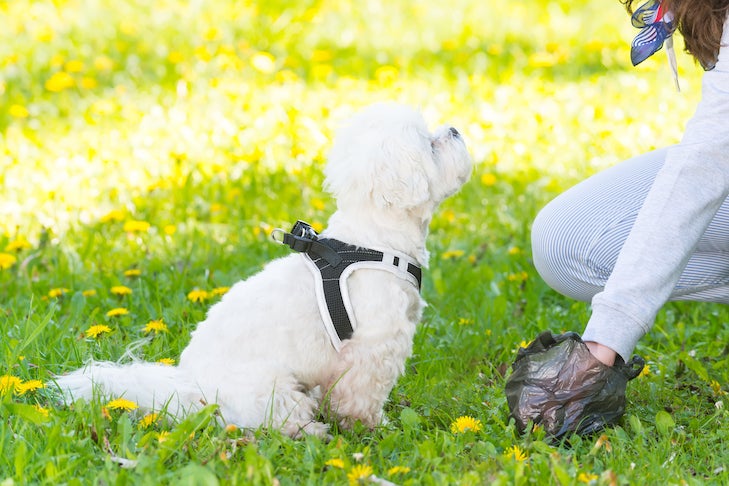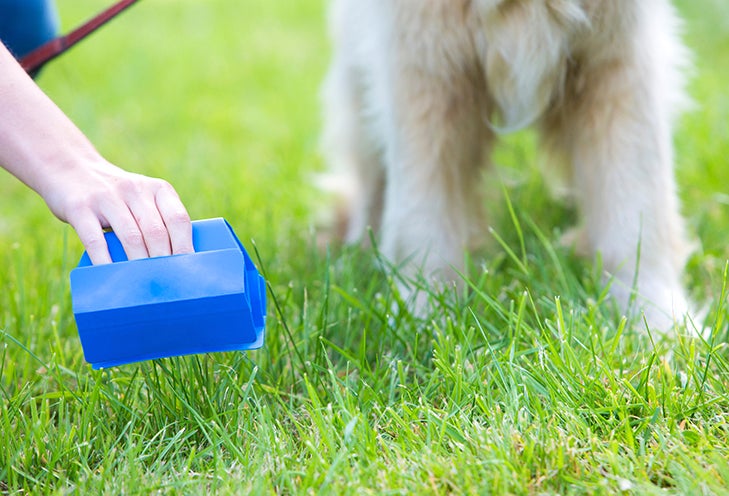AKC is a participant in affiliate advertising programs designed to provide a means for sites to earn advertising fees by advertising and linking to akc.org. If you purchase a product through this article, we may receive a portion of the sale.
There are many invaluable benefits to owning a dog. Having to pick up dog poop maybe isn’t one of them, yet part of being a responsible dog owner is cleaning up after your dog. It’s not only socially unacceptable to leave your dog’s waste lying around, but it’s also an environmental contaminant if you don’t pick it up and dispose of it properly. While you might be tempted to let it lie, here’s the scoop on dog poop disposal.
Why You Should Clean Up After Your Dog
There’s no better way to ruin relationships with your neighbors than to leave your dog’s dropping on their property. Nobody wants to step in dog poop. It’s smelly and unsightly. And for dogs with a coprophagia habit, it’s a tempting snack. It’s common courtesy to stoop and scoop. Even if you’re hiking or camping, you need to pick up your dog’s waste.

You might think dog poop is great fertilizer for your lawn. Or perhaps you think if wild animals can do it, so can your dog. Neither are true. In fact, dog waste is a dangerous source of contamination whether you’re in the city or the wilderness. That’s because when dog poo is left on the ground, it’s washed away by rainwater. In nature, that tainted water makes its way into streams, rivers, and lakes. In town, the water enters the storm drain where it’ll eventually flow into local bodies of water.
Dog Poop Contains Excess Nutrients and Pathogens
So why does it matter if dog poop makes its way into waterways? Well, dog feces contain the nutrients nitrogen and phosphorus. And as dogs in the United States produce millions of tons of poop each year, those nutrients are far more than the water system can handle. This imbalance leads to the overgrowth of algae and weeds, making those bodies of water cloudy and unsuitable for animal or human use.
Cleaning up after your dog also prevents pathogens from entering the water system. Dog poo can contain disease causing parasites like Giardia or worms, as well as bacteria like salmonella or E. coli. Even feces from symptom-free dogs can be contaminated. If these pathogens enter the water supply, they put human health at risk. It’s beneficial to everybody if you pick it up and dispose of it properly.
How to Dispose of Your Dog’s Poop
There are four main options for dog waste disposal. The first is to bury the poop. Although this might seem like the best solution when out in the wilderness, it isn’t particularly convenient anywhere else and risks contaminating the environment. If you must bury, the environmental protection charity Leave No Trace suggests you dig six to eight inches deep and ensure the hole is at least 200 feet from any source of water.
A second option is flushing your dog’s feces down the toilet. Whether this is suitable depends on if your wastewater goes through a sewage treatment plant. If it doesn’t, for example if you have a septic system, don’t flush dog poop as it can contaminate the water supply. Always check with your local government to see if flushing is an acceptable disposal method. Of course, don’t flush anything but the poop down the toilet (and never flush cat feces). If you’ve used a plastic bag to collect the waste, empty it into the toilet then throw the bag into the garbage.

The most convenient option is throwing the feces in the trash. It balances environmental contamination with ease. When out on walks, many parks provide dedicated poop receptacles, or you can carry the waste home in a poop bag. Whatever you do, don’t leave the bag on the ground or hanging from a tree to contribute to environmental contamination or become somebody else’s problem.
Plastic Poop Bags Contribute to Pollution
Plastic poop bags protect your hands, contain odor, and work no matter the weather. But they have a negative impact on the environment by contributing to plastic and microplastic pollution. A recent study in the journal Environmental Pollution estimated that around 415 billion plastic dog poop bags are disposed of every year, which is the equivalent to 0.76 to 1.23 million tons of plastic waste.
Alternatives to plastic poop bags include reusing other plastic bags, such as those from bread or produce, or using newspaper or paper poop bags. However, paper won’t work in the rain or if your dog has diarrhea. Compostable poop bags are a better solution, but they need to be placed in a composter to break down. The conditions in a landfill simply don’t cut it. And be aware that bags labeled “biodegradable” don’t necessarily decompose at a fast rate or in an environmentally friendly way. However, these bags are still a greener option, even in the trash.
Dog Poop Composting Is Environmentally Friendly
Your final option for poop disposal is composting. This is the most environmentally friendly solution; however, home composters may not effectively handle the pathogens in dog poop. You need to use the correct equipment and follow instructions for dog poop composting, such as those from the United States Department of Agriculture. If you do compost your dog’s waste at home, never use the resulting fertilizer on fruit and vegetable gardens as there may still be contaminants.

Although research on home composting is ongoing, industrial composting facilities may currently be best equipped to deal with dog waste. In fact, many locations are implementing city-wide compost programs where dog poop is accepted in the green bin. Poop is collected with other organics and in some cases even the poop bags can go in as well. Check with your local government to see if this option is available to you.
Tips for Cleaning Up After Your Dog
No matter how you choose to dispose of your dog’s waste, always consider hygiene. Keep your hands covered whether it’s with a bag or rubber gloves and thoroughly wash your hands when the task is done. You can also use a pooper scooper device or a rake and shovel, but don’t use the same garden tools for fruit or vegetable gardening if you intend to eat the produce.
It’s also important to always have a poop bag or other means of collection on hand. Keep bags in your pockets or wear a dog treat pouch or fanny pack complete with bags, treats, and a clicker, so you can train or scoop wherever you are. You can also clip a poop bag holder to your belt, purse, or your dog’s leash. But beware of attaching a hard plastic bag holder to your dog’s leash as it can scare your dog if you accidentally drop the leash and the bag holder bangs along behind them.
Finally, know your dog’s potty habits, so you can anticipate when there will be poop to scoop. Most dogs poop once or twice a day and usually not long after eating. You can also teach your dog potty cues to indicate where and when you want them to go. Then you will always be ready to responsibly clean up after your dog.

